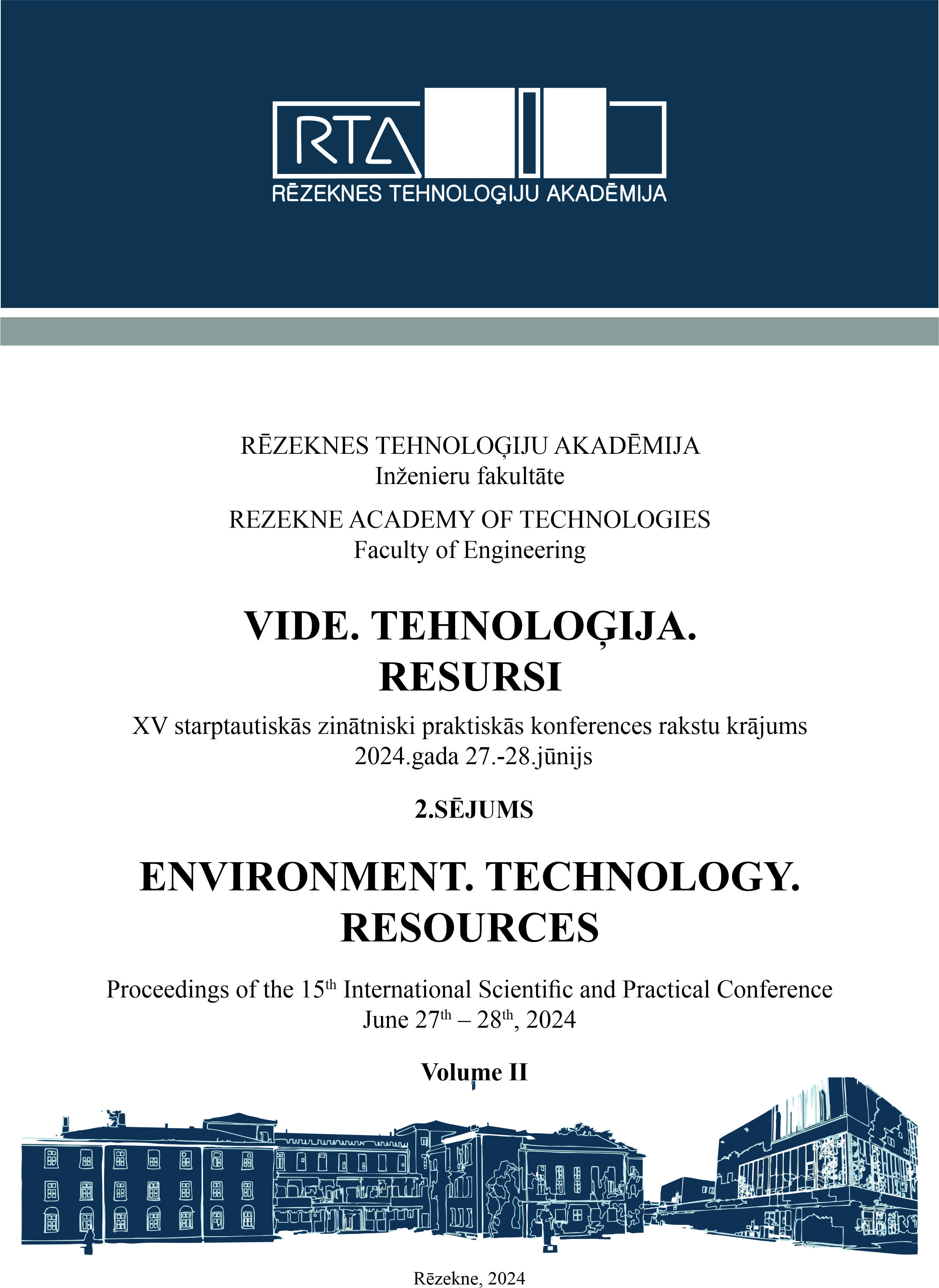DEVELOPING MANAGERS’ INTERCULTURAL COMPETENCE IN SMALL MANUFACTURING ENTERPRISES
DOI:
https://doi.org/10.17770/etr2024vol2.8081Keywords:
intercultural competence development, managers, small manufacturing enterprisesAbstract
Diverse and multicultural environment requires that managers of manufacturing enterprises should be able to work with representatives of different cultures. Seeking to maintain long-term commercial relationships, employees should strive for high level of intercultural competence through constant development. Object of the study – development of intercultural competence of managers. Aim of the study – to assess the development of intercultural competence of managers of small manufacturing enterprises. The qualitative research revealed that managers of small manufacturing companies develop intercultural competence informally, by learning from their own experiences, interacting and communicating in different intercultural situations with foreign customers, buyers, and suppliers. It was identified that the primary obstacle to intercultural communication is the inadequate foreign language proficiency of managers. Small manufacturing enterprises do not contribute to the development of managers' intercultural competence. It is noteworthy that the managers develop their intercultural competence in work setting, by sharing intercultural experiences, especially when they face with challenges or when work in unfamiliar cultural environments or unexpected situations. It can be stated that the Story Circles is an appropriate method for developing the intercultural competence of managers in small manufacturing and export companies with limited financial and human resources.
References
M. Byram, B. Gribkova and H. Starkey, “Developing the intercultural dimension in language teaching: A practical introduction for teachers,” Language Policy Division, Directorate of School, Out-of-School and Higher Education, Council of Europe, 2002. [Online]. Available: https://discovery.ucl.ac.uk. [Accessed Jan. 16, 2023].
A. E. Fantini, “Intercultural Communicative Competence: A Necessary Ability for All,” 2021. [Online]. Available: https://digitalcollections.sit.edu. [Accessed Jan. 13, 2023].
K. L. Liu, “Teaching and assessing intercultural communicative competence (ICC): experience with student-authored critical incidents,” Taiwan Journal of TESOL, vol. 18, no. 1, pp. 1-27, 2021. [Online]. Available: ERIC, https://eric.ed.gov/?id=EJ1288991, [Accessed Nov 15, 2022].
J. Dabravalskytė and J. Vveinhardt, “Lietuvos mažų ir vidutinių įmonių internacionalizacijos ir tarpkultūrinės kompetencijos integracija,” Organizacijų vadyba: sisteminiai tyrimai, vol. 73, pp. 27-47, 2015. [Online]. Available: Lituanistika database, https://etalpykla.lituanistika.lt, [Accessed Feb. 17, 2024], https://www.vdu.lt/cris/entities/publication/efd9a7ae-d799-45ca-bbbe-2b42631ce237
T. Hantsiuk, K. Vintoniv, N. Opar and B. Hryvnak, “Developing intercultural competence through design thinking,” European Integration Studies, vol. 15, pp. 9-21, 2021. [Online]. Available: KTU, https://eis.ktu.lt/index.php/EIS/article/view/28930, [Accessed Nov 15, 2022], https://doi.org/10.5755/j01.eis.1.15.28930
B. W. Haas, “Enhancing the Intercultural Competence of College Students: A Consideration of Applied Teaching Techniques,” International Journal of Multicultural Education, vol. 21, no. 2, pp. 81-96, 2019. [Online]. Available: https://ijme-journal.org. [Accessed Dec. 12, 2022], https://doi.org/10.18251/ijme.v21i2.1696
M. Akdere, K. Acheson, and Y. Jiang, “An examination of the effectiveness of virtual reality technology for intercultural competence development,” International Journal of Intercultural Relations, vo. 82, pp. 109-120, 2021. [Online]. Available: ScienceDirect, https://par.nsf.gov. [Accessed Nov. 25, 2022], https://doi.org/10.1016/j.ijintrel.2021.03.009
P. Sharma and Z. Wu, “Consumer ethnocentrism vs. intercultural competence as moderators in intercultural service encounters,” Journal of Services Marketing, vol. 29, no. 2, pp. 93-102, 2015. [Online]. Available: Emerald Insight, https://www.emerald.com/insight/publication/issn/0887-6045. [Accessed Feb 12, 2023].
K. Leung, S. Ang and M. L. Tan, “Intercultural competence,” The Annual Review of Organizational Psychology and Organizational Behavior, vol. 1, no. 1, pp. 489-519, 2014. [Online]. Available: https://www.annualreviews.org/content/journals/orgpsych. [Accessed Feb 12, 2023]. DOI: 10.1146/annurev-orgpsych-031413-091229
D. K. Deardorff, “Manual for developing intercultural competencies: Story circles,” Routledge Focus: 2020. [Online]. [Available: UNESCO Open Access Repository, https://library.oapen.org. [Accessed Nov 25, 2022], https://library.oapen.org/bitstream/handle/20.500.12657/76006/1/9780429521348.pdf
G. Raţă and E. M. Samfira, “Intercultural Development through Intercultural Awareness and Cultural Briefing,” New Trends and Issues Proceedings on Humanities and Social Sciences, vol. 4, no. 1, pp. 61-67, 2017. [Online]. Available: academia.edu. [Accessed Sept. 15, 2022], https://doi.org/10.18844/prosoc.v4i1.2053
G. Paurienė, “Tarpkultūrinė kompetencija ir jos ugdymas pareigūnų rengime,” Public Security and Public Order, vol. 5, pp. 114-128, 2011. [Online]. Available: https://ojs.mruni.eu/ojs/vsvt/article/view/6157. [Accessed Sept 26, 2022].
E. Gerulaitienė, “Patirtinio mokymosi kitame kultūriniame kontekste ugdymo praktikos, plėtojant tarpkultūrinę kompetenciją, ypatumų analizė,” Jaunųjų mokslininkų darbai, vol. 1, pp. 25-31, 2013. [Online]. Available: epublications.vu.lt. [Accessed Sept 26, 2022].
S. Kairė, “Būti priimtam ar būti matomam: kultūrinio susidūrimo kompleksiškumas vykdant tarpkultūrinį ugdymą,” Acta paedagogica Vilnensia, vol. 34, pp. 9-19, 2015. [Online]. Available: https://epublications.vu.lt/object/elaba:6097569/. [Accessed Sept 26, 2022].
R. Shadiev, X. Wang and Y. M. Huang, “Promoting intercultural competence in a learning activity supported by virtual reality technology,” International Review of Research in Open and Distributed Learning, vol. 21, no. 3, pp. 157-174, 2020. [Online]. Available: ERIC, https://files.eric.ed.gov/fulltext/EJ1267463.pdf. [Accessed Jan 10, 2024].
J. Sell, “Storytelling for intercultural understanding and intercultural sensitivity development,” in Beyond storytelling: Narrative Ansätze und die Arbeit mit Geschichten in Organisationen, J. Chlopczyk, Ed. Wiesbaden: Springer Gabler, 2017, pp. 223-249.
V. M. Gabinus, “The use of Story Circles to promote intercultural competence and thereby benefit PhD students in their research” [Master's thesis]. Høgskolen i Østfold, 2020. [Online]. Available: https://hiof.brage.unit.no. [Accessed Jul 25, 2022].
I. Gheorghiu and C. Antonita, “The Unesco Story, The Circle Method–Creating Bridges Among People,” in Teachers And Students In Multicultural Environments, Ed. M. Iorga, Iaşi: Editura Universităţii Alexandru Ioan Cuza, 2021, pp. 337-368. [Online]. Available: https://increase.grant.umfiasi.ro. [Accessed Sept 26, 2022].
I. Gaižauskaitė and N. Valavičienė, “Socialinių tyrimų metodai: kokybinis interviu: vadovėlis”. Vilnius: Registrų centras, 2016. [Online]. Available: https://cris.mruni.eu. [Accessed Sept. 12, 2022].
LATIA Association of Lithuanian Clothing and Textile Companies. [Online]. Available: https://latia.lt/. [Accessed Sept 12, 2022].
G. Paurienė, “Savaiminio (informaliojo) mokymosi sampratos analizė,” Public Security and Public Order, vol. 10, pp. 181-197, 2013. [Online]. Available: https://www3.mruni.eu. [Accessed Aug 10, 2022].
Downloads
Published
Issue
Section
License
Copyright (c) 2024 Ausra Repeckiene, Renata Zvireliene, Karolina Janickiene

This work is licensed under a Creative Commons Attribution 4.0 International License.



